Are you tired of making your computer desk look cool as you generally see online? But you cannot figure out, what is stopping you to achieve that. Let me tell you, these are the computer cables running over and under your desk, thus creating a mess, and never letting you achieve that cool look of your workstation.
Table of Contents
Guys and Gals, you need not worry as today, I am going to share the easiest and best tips on how to organize computer wires on a desk, in which I will be sharing all my tricks and best methods of cable management.
Having cords in your face or taking up valuable desk space is annoying, and we’ve all been there before. There are ways to hide those pesky cords in your office space and keep your desk looking clean and organized from the tangled mess, letting you achieve the perfect pc setup.
The easiest way to organize computer wires is by laying out a complete map of your cables and then exactly sorting out the route of each cable, in order to ascertain which cables can be tied/routed together. Afterward, by utilizing the cable management kit, first, tie all the cables together having the same route and then attach all the cables along the desk from the underside. That’s the easiest way to hide cords.
Without waiting further, let’s check out the best ways on how to hide computer cords on your desk for every need and demand, whether you want a permanent or temporary solution.
Important Considerations!
1. Permanent Setup Vs. Flexible
As a personal experience, I’ve had the best results with a mix of both flexible and permanent options. The main reason is that some solutions are much easier and quicker to implement than others, as it all depends on your needs.
You might not have the time to invest in a more permanent solution and need a quick fix for an upcoming event.
On the other hand, you might be sick of seeing all the cords everywhere and be looking for a more long-term permanent solution that declutters your desk for good.
Flexible options are also perfect if you’re a renter and can’t make any changes to the property.
Before you start worrying about how to aesthetically hide your cords, it’s important that you take the time to declutter and organize them. This way, you’ll know exactly which cord needs to be plugged in and where so that you can easily find a creative solution.
2. Setting up all of your devices
To avoid any stressful surprises, make sure all of your devices are set up and ready before you need to use them. To keep things simple, sort your multiple or single cable by function; for example, power extension cord, computer/laptop cords, chargers, etc. This will help you determine where they need to go and how you can properly organize them.
3. Create a blueprint
Start mapping out where you need to put each element. This will save you time in the long run and help you avoid any stressful setbacks. For example, if you have a computer, printer, and monitor that are all going on the same desk, be sure to give them enough space and arrange them in a way that allows easy access to cords.
Now let’s explore all the practical ways to hide cables.
Top 25 Best Ways to Organize Computer Wires
1. Under-Desk Basket, aka Under Desk Cable Tray
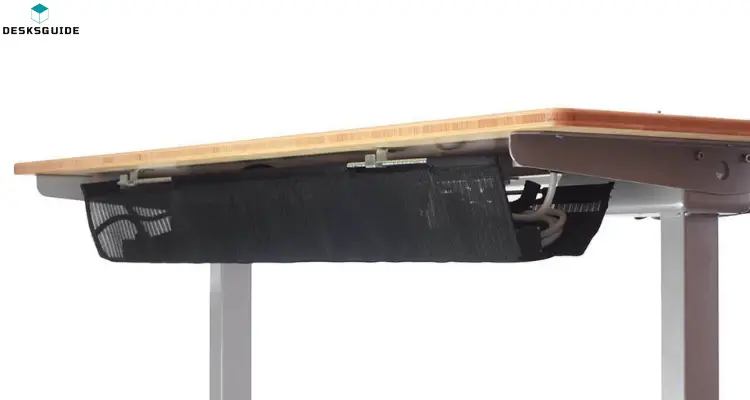
An under-desk basket is a wonderful way to hide computer cords and keep them easily accessible if you have the available space.
I absolutely love wire baskets for their combination of attractiveness, durability, and airflow around the cords, which helps prevent overheating.
Under-desk wire basket offers easy cord management with the option to move it around as needed; plus, if your desk has a closed back, it provides hidden cord storage while still allowing airflow.
One thing to note before purchasing is that you can count it as a permanent and easy solution, as the installation requires drilling holes into the desk.
2. Cable Catch
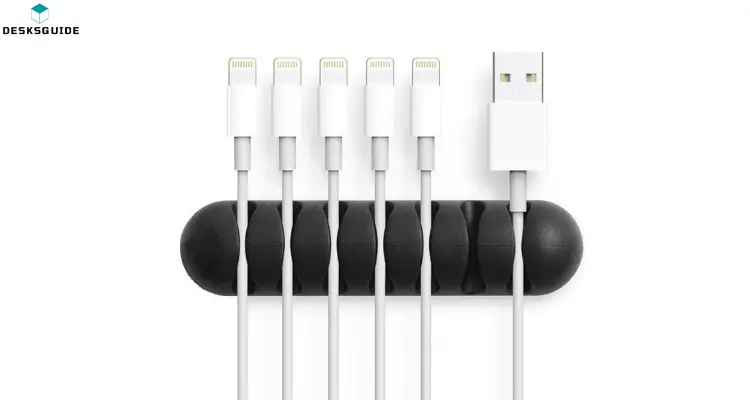
A cable catch is an easy way to keep cords tidy and hidden on the back of your desk. It’s a small plastic clip that you stick onto the back of your desk and slip cords through so they’re out of sight.
You can count cable catch as a basic cord management solution which is ideal if you’ve got wires dangling from your PC down behind your desk. Plus, it’s great for desks in the middle of a room since only one side will be visible!
Also, these cable catches are cheap and easy to install, making them a great solution for those who are looking for a temporary or cheap fix and do not want to make any permanent changes to their desk.
3. Cable Sleeve
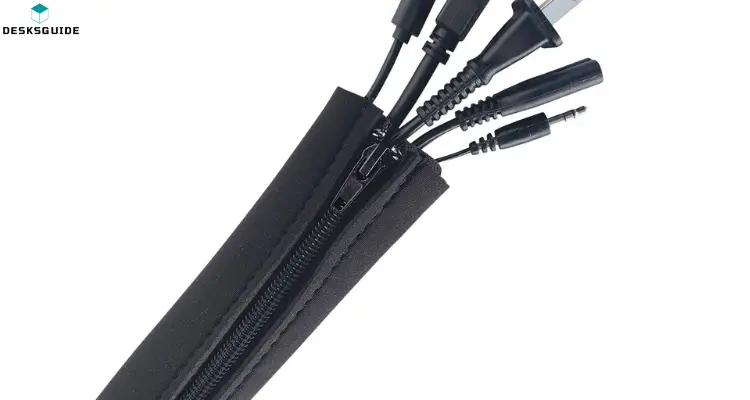
Cable sleeves are an excellent way to declutter and organize your computer desk. You can group cords that run in the same direction together and conceal them using cable sleeves. This will also prevent tangles and make unplugging easier.
Cord-cutters will love this zip-up cable sleeve for its length and customization options. I would also like to point out that it offers some protection from heat damage, although I’m not sure if there’s any scientific evidence to support this claim. Nevertheless, it’s always good to know that all of your cords are protected!
4. Velcro Straps
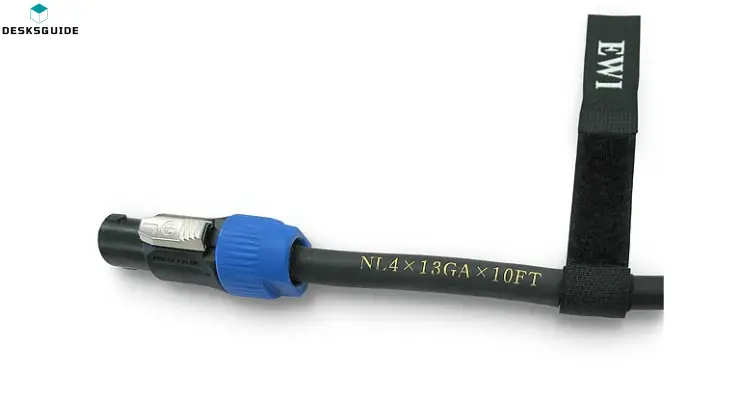
Velcro straps are simple utility solutions that keep cords organized and in place without hiding them completely. In addition, velcro straps can be quickly removed and reapplied as needed, making them more adjustable and reusable than zip ties or cable sleeves.
How I Used Velcro Staps:
- Decide where on your desk you want to attach the velcro straps. It’s best to place them where the cords are already grouped together, like the nearest outlet or computer.
- Cut the straps to the desired length and attach the velcro pieces accordingly. Make sure that the strap is tight enough so that the cords don’t move around, but not so tight that they’re constricted.
- Use the extra velcro piece to keep the loose end of the strap together.
- Repeat these steps for each grouping of cords on your desk or near the wall outlet.
5. Double-Sided Tape
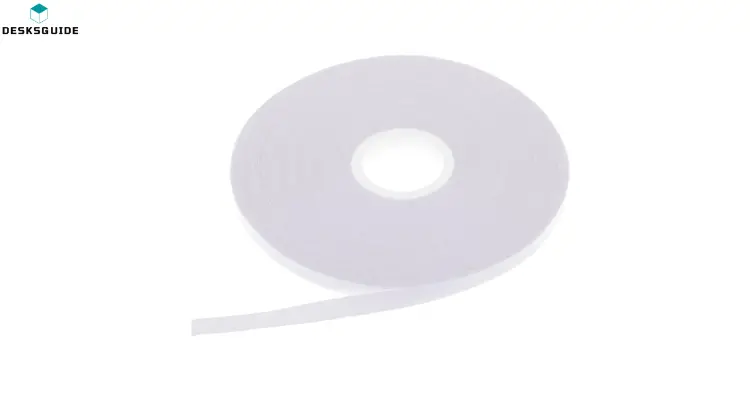
Double-sided tape is the way to go if you’re looking for a quick and temporary solution. Stick a few pieces of double-sided tape on the flat side of a power strip or at the back of your desk, and run your cords along it, hiding power strips from view.
Be aware, though, that this isn’t recommended for extended use because, eventually, the adhesive might not stick as well. Therefore, I recommend using double-sided tape to solve minor cord issues or temporarily until you can get a better permanent solution.
Duct tape or electric tape can also work in a pinch, but they may not offer the same holding power as double-sided tape.
6. Cord Tape

Similar to double-sided tape, cord tape allows you to stick cords onto surfaces, hiding them from view. However, the main difference is that it’s designed explicitly for cords with a rough surface that allows the tape to adhere better and for more extended periods of time.
Sometimes, cord tape can also be velcro-like, allowing you to wrap the cords and secure them in place without sticking them onto a surface.
7. Binder Clips
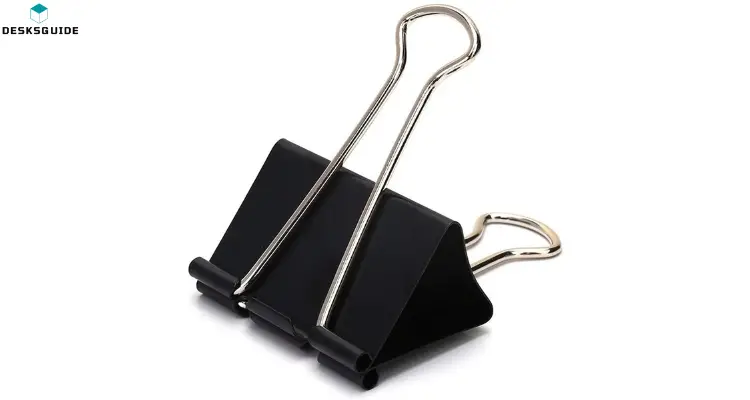
Binder clips are a smart option for those wanting to keep cords organized in their home office workspace without investing in any additional products. Instead, clamp the binder clip onto your desk and use it as a cord holder or bundle multiple thick wires together.
Binder clips are versatile and can also be used on walls or other spaces around your office for cord organization. Plus, they come in various sizes, so you can find one to fit your needs.
8. BRIGHTTIA Gold Cable Organizer Clips

If you’re looking for a more elegant way to organize your cords, look no further than the BRIGHTTIA Gold Cable Organizer Clips. These small buttons stick onto surfaces and hold your cables in place with style.
Plus, they’re easy to use – simply rotate the top part of the clip to open it, place your cable, and then rotate it back into place to close. These clips come in a pack and can hold multiple cables at once. It’s the perfect solution for those wanting to add some sophistication to their cord organization.
9. Flat Cord Protector, AKA Compact Cord Protector
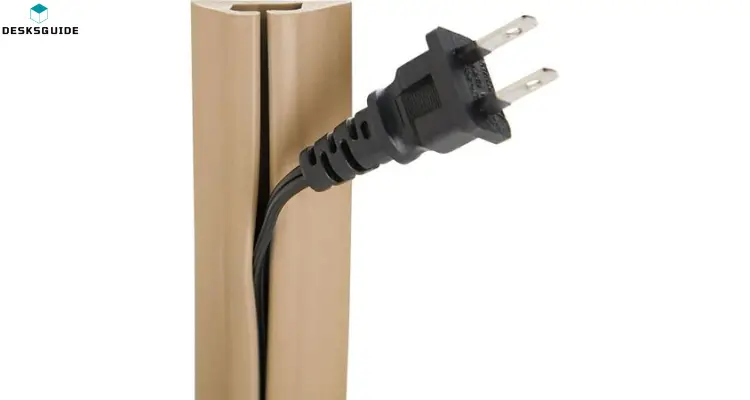
If you’ve ever thought about how to hide cords on the floor, a flat cord protector is a solution. It’s a long strip with adhesive on one side that allows you to stick it onto the floor and run your cords along it, hiding them from view.
It is perfect for those with multiple cords running along the floor, such as in a conference room setting or home office. Plus, it offers some protection from foot traffic and potential tripping hazards. This cable protector doesn’t use glue or adhesive, covering those who don’t want to damage their floors.
10. J-Channel Cable Raceway

If you’re looking for a more permanent solution to hide cables on the wall or even on the back of your desk, the bottom of it or even the legs of furniture, the J-Channel Cable Raceway is a great option. Like flat cord protectors, the J-Channel Cable Raceway can be stuck onto surfaces with adhesive, allowing you to run cords along it for a clean, organized appearance.
I remember using this solution at my previous office once, and it worked well. Plus, it’s easy to install and can be painted over to match your home or office decor.
11. Cable Box
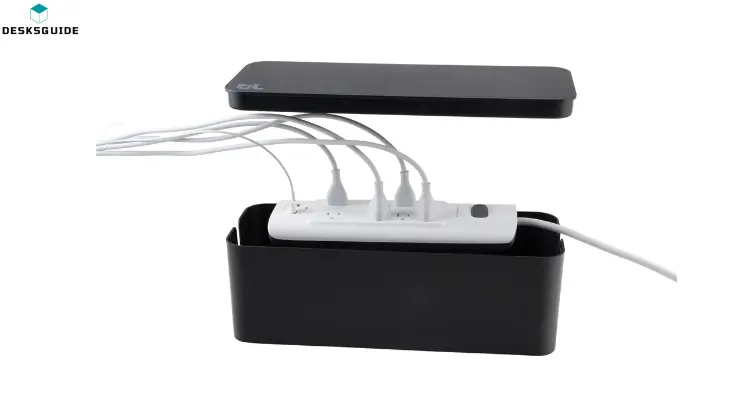
If you want to clean up your computer desk, counter, or entertainment center, consider getting a cable box or cord organizer. This is especially helpful if you have power strips on your desk since they can Hide the power cords and make your workspace look neater.
It is the perfect device for hiding cables on a desk or countertop. It has enough room to accommodate all of your necessary cables, including phones, tablets, laptop chargers, and more. I was hoping you wouldn’t laugh, but I like to think of it as a lunch box for cables because of its compact and cute design.
12. Cable Kit for Hiding Computer Cords
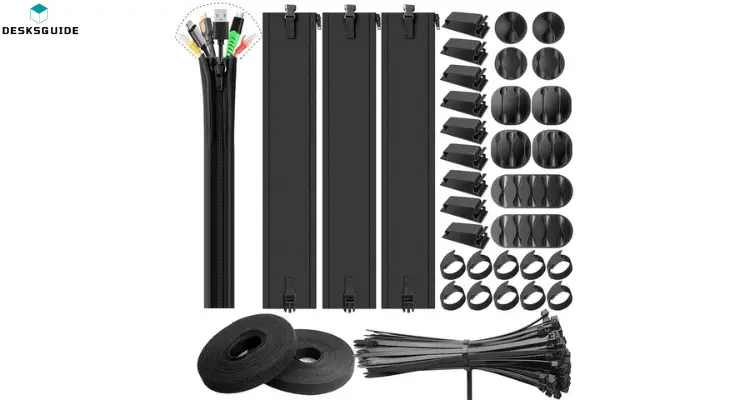
Consider getting a cable kit if you want a complete solution for hiding computer cords on your desk or countertop. This usually includes various items such as cable sleeves, clips, and a cord organizer box to avoid cable clutter.
This set consists of cable sleeves, clips, and a cord organizer box to conceal computer cords effectively. Ideal for those seeking a comprehensive solution for desk cable management.
13. Charging Station

With more and more electronic devices being released each year, it’s no surprise that people are looking for better ways to organize and charge their devices. A charging station is a great way to achieve this, as it minimizes the number of power strips on your desk and keeps all your devices organized in one place.
The is not only a space-saver but also efficient and clean. This modern accessory will hold your phone charger, watch, and AirPods while charging them all at once without a mess of cords on your desk.
14. Use furniture with a Built-In Cord Management Tray
If you want to tuck away your cords for good, buy a desk or piece of furniture with integrated cord management trays. These cable tray dispatch cords under desks and tidily store them out of view.
No doubt, it’s a more expensive solution, but if you have the budget, investing in furniture with built-in cord management is worth it for a permanently clean and organized workspace.
One option is the Unikito L Shaped Computer Desk, which has a built-in cord management system along with cubbies for storage and organization.
15. Hole in the Bottom or Back of the Cabinet
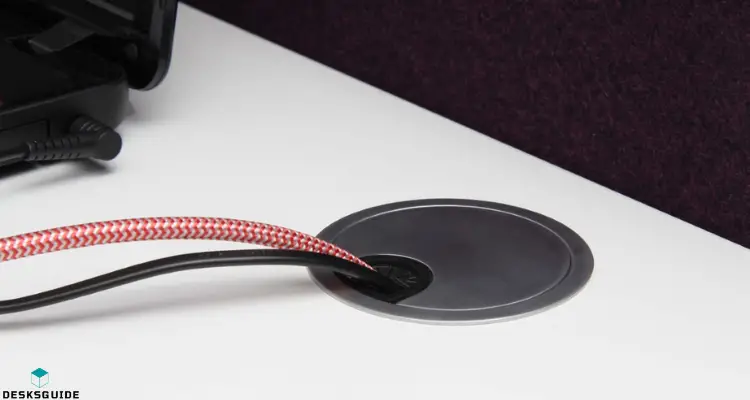
For a more permanent solution, you can always drill a hole in the bottom or back of your desk cabinet to run cords through. This will completely hide them from view and keep your desk clutter-free. Just make sure you have the proper tools and know-how before attempting this solution. For example, if drilling a hole in the bottom of your cabinet, be sure to check for any important wires or pipes first before proceeding. I also recommend consulting a professional for assistance with this method.
Also, consider purchasing cord covers to hide any exposed cords in the back of your desk or cabinet. This will not only give your workspace a clean and professional look, but it will also prevent any potential accidents or mishaps.
16. Under-Desk Privacy Screen
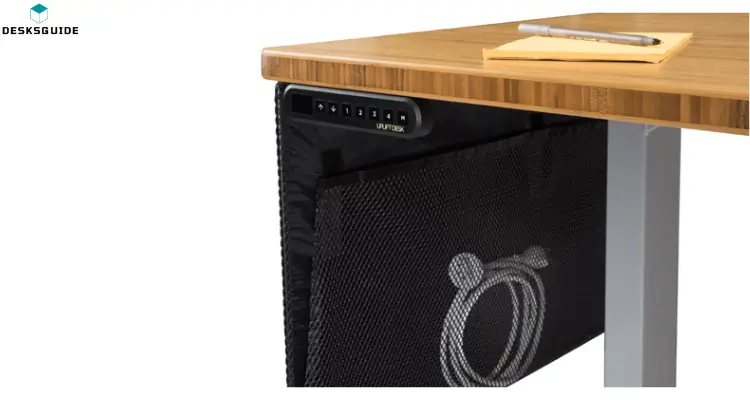
Do you have a PC desk setup in a shared workspace or an open office? An under-desk privacy screen can hide computer wires and provide extra privacy for your work area.
Usually, these panels attach to the underside of a desk and have cord access ports for concealing power cords while also adding a barrier between you and neighboring desks. It’s an excellent solution for hiding cords in a shared workspace.
17. Switch to Wireless

After exploring all other options, switch to wireless devices. This will eliminate cords on your desk completely and make everything look neater. Of course, this solution might only work for some because it often demands buying new devices. Even so, it’s definitely worth thinking about if you want a cord-free desk setup.
Whether you need to hide keyboard or mouse cords, headphones, or speaker wires, making your setup wireless can create a cleaner and more organized workspace. Not to mention that it’s a great long-term solution for hiding cords on your desk in general!
18. Running the Wires under Rugs / Carpets
Do you have a rug on your desk, or is your floor carpeted? Running wires underneath can hide them from view and keep them out of the way. However, ensure not to cover the cords too much as it can cause overheating or damage. And always unplug your devices before attempting to run the wires underneath a carpet or rug.
In addition, be careful not to trip over any exposed wires while walking around your desk. It may be necessary to tape them down or use cord covers to prevent tripping hazards.
19. Stow Cables in Cabinets
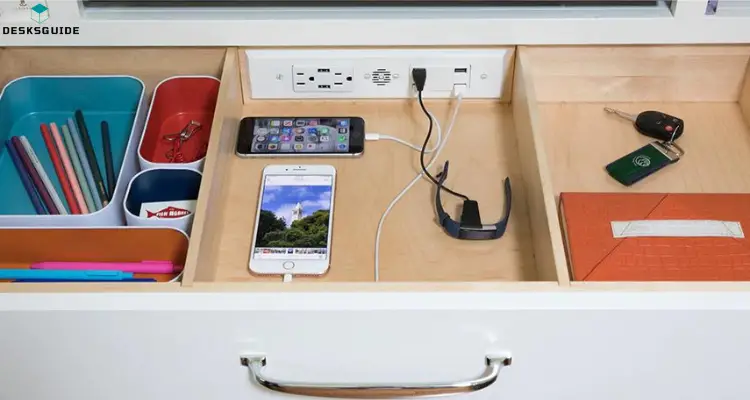
If your desk has cabinets or drawers, utilize them to stow away any extra cords and cables. Again, I think this is something you should do even if you have successfully hidden the cords on your desk.
Keeping them tucked away in a drawer or cabinet will prevent tangles and make for a clutter-free workspace.
Additionally, it’s safer to have cords stowed away when not in use, as they won’t be a tripping hazard for you or anyone else in the area.
20. Use an Old Shoebox – DIY Solution
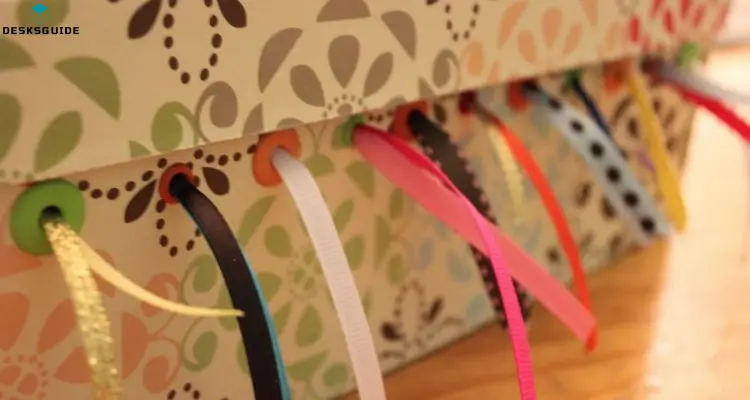
If you have an old shoebox lying around your desk chair, repurpose it into a cord-hiding solution by cutting a hole in the top and running the cords through it. Then, place the box under your desk to hide the cables from view. This is a quick and easy DIY solution that can also add some fun decoration to your desk.
Just make sure not to overload the shoebox with too many cords, as it may not be able to support the weight.
21. Decorate with Washi Tape – DIY Solution

Another creative way to hide wires on a computer desk is using washi tape. This decorative tape comes in various patterns and colors, allowing you to add some personality to your cord organization. Use it to stick down loose cords or even wrap around thicker cords for added concealment.
Washi tape is also easily removable, making it a non-permanent solution for hiding cords on your desk.
22. Ribbons – DIY Solution
You know what once I had some very long monitor cords, and they were hanging down on the desk. So, what I did was tie a ribbon around them in matching paint color to my desk. It looked much nicer!
Ribbons are another creative and inexpensive way to hide computer wires on your desk. Just make sure to choose a sturdy ribbon that won’t fray or come undone easily.
23. Hide Cords behind a Monitor:

If you have a monitor with a stand, use it to hide all your cables by routing them through the stand and attaching them to the back of the monitor. This way, they will be out of sight and off your desk.
Not only does it provide space for organizing and hiding cords, but it also raises your monitor to a comfortable viewing level.
24. Make a Cord Holder out of Clay- DIY Solution
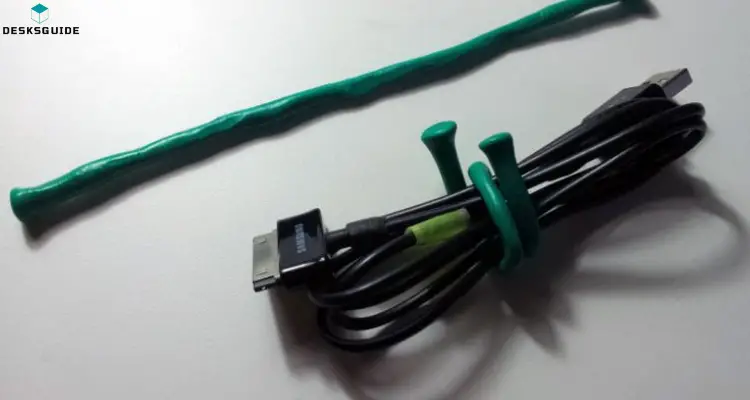
Do you know how to work with clay? Use this skill to make a cord holder that you can stick onto your desk. This adds a creative and personalized touch to hiding cords on your desk.
You can mold the clay into any shape or design you want and make holes for the cords to go through. Plus, it’s an affordable DIY solution if you already have clay on hand.
However, this may not be the best solution for hiding wires. It’s also important to note that clay holders should only be used with lightweight cords and cables.
25. Toilet Paper Rolls – DIY Solution
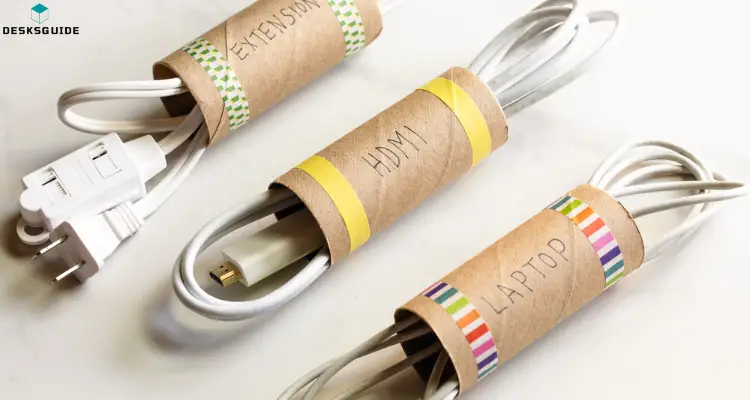
You may be surprised to hear this, but toilet paper rolls can actually be used to hide cords on a desk. Simply cut the roll in half and place the cord inside before taping it shut. It’s a unique and budget-friendly solution for concealing those pesky cords.
Just make sure to use only a few toilet paper rolls, as they may not be able to hold the weight of thicker cords. And, if possible, try decorating or painting the rolls to blend in with your desk. This can make them less noticeable.
Best Ways For Hiding Keyboard and Mouse Cables
The recommended way to hide keyboard and mouse cables is by making a hole in the middle of the table to pass the cable through. Another option would be to use cable clips or conceal wires under the desk. More options are listed below:
- Utilize cable clips to stick the cords down and out of the way
- Use a cord organizer to gather and conceal the wires on your desk
- Hide them behind your computer monitor
- Invest in wireless keyboard and mouse options to eliminate the cords altogether
- Consider purchasing a desk with built-in cord management features.
For more solutions, check out this guide.
Video Recommendations: How to Organize Computer Wires on a Desk?
Conclusion
There are many ways to How to organize computer wires on a Desk on a desk, ranging from DIY solutions to purchasing cord management products. No matter which solution you choose, hiding computer cords on your desk can make for a cleaner and more organized workspace. Give some of these ideas a try and see how they can transform the look of your desk. Happy organizing!
Frequently Asked Questions
Q. How can I hide the wires behind my desk?
A. You can hide the wires behind your desk by using the different methods mentioned above, routing them through a hole in the desk, or concealing them under the desk. Investing in wireless devices can also help eliminate the wires altogether. Additionally, desks with built-in cord management features may be a good option. Moreover, you can also check out our detailed guide on How to organize a desk here.
Q. How can I keep my computer wires protected on the floor?
A. You can keep your computer wires protected on the floor by using flat cord protector covers or using velcro straps to wrap them together and keep them organized. If you’re looking for more of an organizational solution, cable ties or zip ties are perfect for wrapping cords together and preventing tangles. Additionally, if your floor is carpeted, running wires underneath can hide them from view and prevent them from tangling.
Q. How to declutter your computer desk?
A. Computer cables are a major source of desk cluttering. Some ideas for hiding cords under a desk include using cable sleeves or clips to stick them down. Investing in a cord organizer, or purchasing a desk with built-in cord management features, are also good options. Another option is to route the cords through a hole in the desk. Moreover, you can check our detailed guide on how to make your gaming desk look minimalist here.
Q. Can I hide cords behind my computer monitor?
A. Yes, you can hide cords behind your computer monitor by attaching them to the back of the stand. Just make sure that the cords are not being stretched or strained in any way.
For more informational articles and buying guides, check out here on Desksguide.com